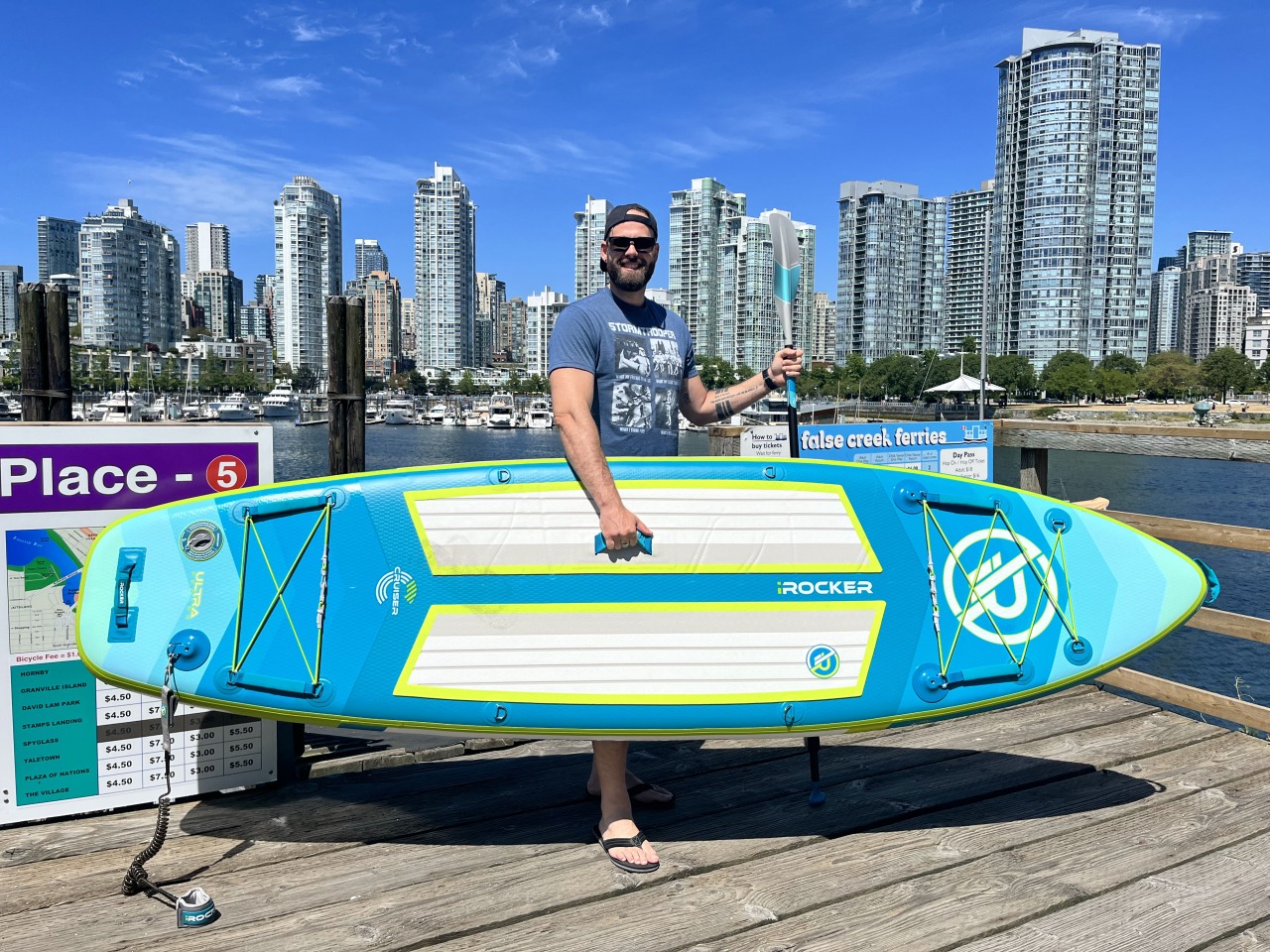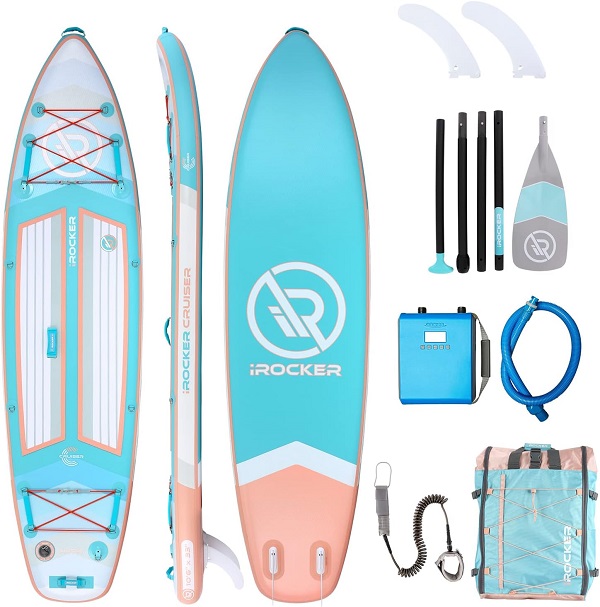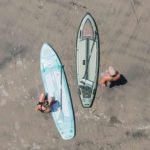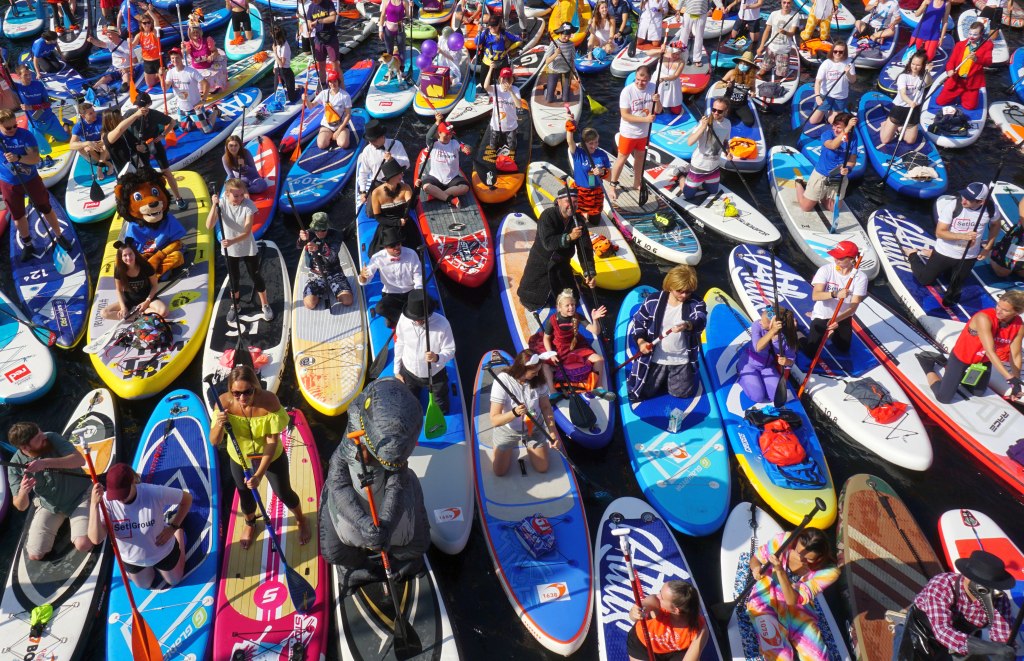Why the right size paddle board matters? From this guide you'll know everything necessary to find the paddle board best sized for you.

I’ve been an iRocker fan for years now.
I’ve been rocking one of the Cruiser boards ever since I took up paddleboarding. In fact, it’s what I learned to paddle board on!
So when I got my hands on their newest-model Ultra 2.0 SUPs, I was excited to put it to the test and see how it stacked up against not only previous iRocker models, but other SUPs I’ve tested.
Below, you can read my full, in-depth review and find out everything you need to know about this board.
I’ll share the things I liked, the flaws I found with it, and my thoughts on whether or not it’s a SUP worth the investment.
Let’s dive in!
Size and Weight

Length: 10’6” (320 cm)
Width: 33” (83.8 cm)
Weight: 21 lbs. (9.5 kg)
Capacity: 300 lbs. (136 kg)
Right off the bat, the Cruiser Ultra 2.0 impressed me with the size of its bag.
Look at this picture of the last SUP I tested, the BodyGlove Performer:

It packs into a pretty tall bag, roughly the length of my entire torso. The bag barely fits into the trunk of my Toyota Corolla, and it’s too long for me to put two of them end to end on the back seat of the car.
Not so with the Cruiser Ultra 2.0.
Look at the bag it comes packed in, and you’ll see it’s much shorter by comparison:

I could easily fit it into my Corolla’s trunk with room to spare for extra storage. It was also short enough that I could fit two end to end in the back seat, meaning I had space to stack four SUPs high (rather than just two like with other boards that come in a longer bag).
Yes, the backpack is a bit wider, but it’s still more portable and packable than any other SUP I’ve tested to date.
iRocker claims its Ultra 2.0 line of SUPs is “their lightest, most travel-friendly paddle boards to date”. This may be true size-wise, but when it comes to weight, the board is nothing special.
The board weighs 21 lbs., which is about average for 10’6” SUPs.
It’s definitely not excessively heavy—I can haul it for a mile or two without feeling the strain—but not miraculously light, either.
When you add in the extra accessories (which I’ll talk about below), it ends up being about the same weight as any other SUP package I’ve tested—a little over 30 pounds.
Fully inflated, it’s 10’6” long, 33” wide, and 6” thick, just the right size for me:

What’s in the Bag?
Unzip the bag, and you can see inside that everything is neatly packaged in both sturdy plastic and padding:

This does a good job of keeping the board safe while traveling, but it proved a bit of a hassle to unpack for the first time (it took about 5 minutes to get it all unwrapped and haul away the trash).
Once it’s unpacked, you can see everything that comes in the package:
- The neatly folded SUP, with a nice thick strap to secure it when packing it away
- The 10’ leash (which is longer than the 9’ leash that comes with other iRocker SUPs)
- A five-piece paddle (which has some major “pros” but also some “cons”)
- Two 9” fins (also some major “pros” and some “cons”)
- Patch kit
- iRocker Electric Pump (which added MAJOR value to the kit and made it much easier to inflate, as I’ll explain below) complete with hose and alligator clips to attach directly to 12V battery
Materials and Construction
All iRocker’s boards (including the Blackfin and Nautical boards) are made using military-grade PVC.
Some of their budget-friendly boards are made using single-layer PVC sheets. But the Cruiser Ultra 2.0 is made from dual-layer PVC, making it tougher, more resilient, and less likely to pop or sustain damage from prolonged sunlight exposure or frequent use.
Their heavier-duty boards use drop-stitch technology that adds durability, but that’s not the case with the Cruiser Ultra 2.0. This board was built to be ultra-light and portable, so iRocker opted not to use drop-stitching.
Does this compromise the durability or longevity of the board? The Ultra 2.0 line of SUPs is new enough that users haven’t yet had time to put years of use on their boards, so it’ll take a few years to find out how long these paddle boards will last.
However, I will say that based on my experience, the board felt as sturdy and well-built as any mid-tier inflatable SUP I’ve tested. It’s still brand-new, though, so I’ll be paying close attention to how well it withstands years of use.
(If—or, better said, when—it starts showing signs of wear and tear, I’ll update this article so you can be aware of any issues as they arise.)
Inflation and Assembly
Thanks to the electric pump included in the bag, I could inflate the board without having to lift a finger to pump it up.

In fact, the bag doesn’t even come with a hand pump. This is definitely a first for me—even the BodyGlove Performer 11, which included an electric pump in the bag, also had a hand pump as a backup just in case.
iRocker’s electric pump has a solid reputation for performance and reliability. It’s backed by a 1-year warranty. But down the road (in 2-3 years), I may find the inclusion of only an electric pump and no hand pump works against me if/when the electric pump malfunctions.
But in this test, the pump did a spectacular job of inflating the board. The inflation time was around 10 minutes (which is faster than most of the other electric pumps I’ve tested). Thanks to the iRocker Portable Battery, I didn’t have to connect it to my car but could simply inflate it directly beside the dock where I planned to launch from.

Interestingly enough, the recommended PSI range for this board isn’t the usual 13 to 17 PSI, but 12 to 16 PSI. For smaller, lighter paddlers, 12 PSI should be more than enough. Given that I’m a bit on the heavier side, I set it to 14 PSI for this test.
While the board was inflating, I went to work assembling the other accessories.
First, I started off with the paddle:

I’m accustomed to three-piece paddles, so finding a five-piece was a bit strange for me. It makes sense to include more components—it’ll fit more easily into the shorter backpack—but as I’ll explain below in the “Performance” section, there were some downsides to this particular paddle and its construction.
Next, I attached the leash to the provided D-ring. I loved the leash design—it includes an extra loop that I could use as a paddle keeper:

No more losing my paddle while I’m floating, relaxing, or doing SUP Yoga.
As I was inflating the board, I noticed it had one really cool feature that I wasn’t expecting.
In addition to a bunch of D-rings and the bungee storage, there are three threaded screw mounts—two on the front, one in the rear:

Had I known about these beforehand (they are mentioned nowhere on the iRocker Cruise Ultra 2.0 sales page), I’d have brought along my iRocker fishing rod holder to test it out.
Still, just the fact that they’re there means I’ve got three spots to mount accessories—a great addition to the board, to say the least.
Finally, once the board was inflated, it was time to attach the two 9” fins and get paddling.

You can see in the image above that the fins come with both a locking mechanism (on the rear of the mount) and a tether that clicks into place so that the fins will never get lost even if they get disconnected. As you’ll read in the “Performance” section, that particular feature saved my butt!
Weight Capacity
This is one of the downsides of the Cruiser Ultra 2.0 for me, specifically.
I’m a big guy, standing 6’6” and weighing around 250 pounds. I also like to pack a bit of extra gear:
- My 50L Sea to Summit Big River Dry bag, where I carry my speakers, snacks, dry clothes, a portable battery, sunscreen, folding chair, and other essentials.
- An umbrella (because who wants to get sunburned?)
- 5-pound anchor
- Inflatable pillow
- Extra folding chair for my wife

Unfortunately, when you add in all this extra weight, it adds up to around 280 or 290 pounds. If I add in a drinks cooler, that pushes it up to 300+ pounds.
Which is a problem (for me) because the board only has a 300-pound weight capacity.
For the average person (under 200 pounds), though, it shouldn’t be an issue. My 5’3” wife can load it down all she wants and she’ll never come close to reaching the weight capacity.
Performance
Now we get into the real heart of the matter: how well the SUP performs when out on the water.
According to the iRocker website, the Cruiser Ultra 2.0 is built to be “the most stable board on the market.” I decided to put that claim to the test not on a flat lake or slow-moving river but on the coastal inlet waters of Vancouver’s False Creek.

With the board loaded, leash strapped to my ankle, and sunglasses on, I headed out onto the waters.

And immediately began to struggle. My board just would not go straight, no matter what I did.
I spent about 10 minutes fighting against the current, the wake of passing boats, and my board. All the time, I was utterly at a loss as to what was the problem, why the board that should have been such a great performer just wasn’t working.
When I reached a floating dock, I hopped off my board to investigate.
Turns out I failed to lock the fins fully in place. The moment I hit the water, they had slid out of the mount.
I quickly pulled up the How-To video from iRocker on my phone to figure out what was going wrong:
Like an absolute genius, I had lifted up the locking mechanism to slide the fins in place, then failed to push it down again.
Yeah, that’s my bad!
Thankfully, the fin leashes saved my butt. The leashes had kept the disconnected fins tethered to the board so they didn’t instantly sink to the bottom of False Creek. That is a feature I will always appreciate and use every time.
With the fins now securely in place, I was ready to head back out onto the water.
And what a difference that made!
Where before I had been struggling against the current (flowing into the inlet when I was paddling out to sea), the wakes of every boat that passed (and there are a lot of them!), and my balance, everything just got so much easier.
I was able to make speedy forward progress with far less effort, cut tight turns and maneuver easily between boats and docks, and remain very balanced even when the water was choppy and turgid.
The 33” width and 6” thickness really come into play here. The board is just wide and thick enough to have high primary stability without sacrificing too much secondary stability.
The addition of two 9” fins also adds to stability. I had no trouble riding the swells and gentle currents on this board.

I will say it’s one of the faster SUPs I’ve tested, and really zips through the water with surprisingly little effort. It also handles well and tracks very straight thanks to the two fins.
But while the SUP itself performs very well, I found the paddle didn’t.
When the paddle is fully assembled with all five components locked in place, the top part (with the grip) doesn’t slide down all the way into the housing. That makes it 3-6 inches too long for me (a big, tall guy) to easily paddle on my knees.
In order to paddle on my knees, I had to remove one of the two lower sections, then extend the top part of the paddle halfway. But when it came time to stand up, I had to go through the hassle of re-connecting the lower section, then adjusting the paddle another hole or two longer so I could comfortably paddle standing up.
I don’t know if I’m the only one who got a defective paddle or if this is an issue across the board, but it definitely proved a major source of frustration for me. The currents and swells of False Creek occasionally compelled me to paddle on my knees, so it was a pain in the neck to have to disconnect and reconnect the paddle.
Plus, there’s always the risk that the extra paddle section would fall overboard or get lost, and I’d be in serious trouble.
Another issue I found with the paddle was that it wasn’t quite as sturdy as the three-piece paddles I’ve tested.
With five potential weak spots at the joints, it wobbled a bit more than I’d like, and I worry that hardcore use will break it. It’s the downside of a paddle that packs down smaller.
Features
The iRocker Cruiser Ultra 2.0 comes with some nifty features:
- Padded carrying handles in the center and at both ends of the board
- Three action mounts (as shown in the image above)
- Extra D-rings around the perimeter of the board to connect a kayak seat, cooler, and other attachments
- Great storage capacity, thanks to its three-point front bungee cord storage and two-point rear storage.
It’s not the most feature-rich board, but what features it has are very useful for my style of paddleboarding.
Comfort
When I’m standing up on the deck pad, it’s as soft, well-cushioned, and supportive as I could ask for. My feet never felt tired even after an hour of paddling against the current, and the deck pad was very nicely responsive to the minute movements of my foot muscles.
But when I was kneeling, I found that my legs were just too long to fit on the deck pad. Instead, my toes were pressed into the PVC deck just behind the end of the deck pad.
I ended up with the skin on my toes being rubbed a bit raw by the constant friction that resulted from my fight to keep my feet from slipping (PVC is very slippery when wet).
Again, I’d say this is a problem that is fairly unique to my taller-than-average physique. When my wife used the board, her shorter legs fit on the deck pad easily.
But if you’re looking for a board to do SUP Yoga, it’s good to know the deck pad is a bit on the shorter side.
Deflation and Packing
Deflating and packing the board was almost as easy as pie.
All SUPs come with a Halkey-Robets release valve that you push down to let the air out. With every other SUP I’ve tested and used to date, you push down the valve and it stays down. Not so with the iRocker Cruiser Ultra 2.0. I had to hold it down to let it deflate. If I let it go, it popped back up and wouldn’t let the air out.
Once most of the air had been let out, I connected it to the Electric Pump’s “deflate” setting and let it suck the last of the air out. That made it wonderfully easy to fold up—right up until the end, when I had to again manually push down the valve to let out a bit of air the pump hadn’t fully sucked out.
The rest of the packing process proved a breeze, however. It took all of three minutes to fold the SUP in half, roll it up, secure it in place with the strap, and pack it into the backpack along with the pump bag (which also has a nice outer pockets for the fin).
Who is this SUP For?
Based on my testing, I’d recommend the iRocker Cruiser Ultra 2.0 to:
- Anyone who wants a light, portable SUP to take commuting or on a holiday abroad.
- Newbies who want a board that is stable but still handles well.
- River and lake paddlers, as well as anyone paddling calmer coastal waters.
- Casual paddlers looking for a speeder, more responsive ride.
Warranty
One great thing about the iRocker Cruiser Ultra 2.0 (and all of the iRocker and Blackfin line of boards) is that they come with a 2-year warranty rather than the 1-year warranty standard with most inflatable SUPs.
The board is backed by a 3-year warranty against side seam leaks, but the 2-year warranty covers:
- Seam leaks
- Excessive workmanship defects
- Handles
Having tested the board myself, I can say with a fair amount of confidence it will outlast the warranty (provided there are no manufacturer’s defects I have yet to encounter).
Closing Thoughts
After testing out the iRocker Cruiser Ultra 2.0, I can confidently say that it’s earned my approval—so much so that I’m going to make it my go-to SUP.
Sure, it’s got a couple of issues: the paddle design is flawed, the deflation process is a bit painstaking, the deck pad is a bit too short for my long legs, and I can’t load it down too heavily thanks to its lower-than-ideal weight capacity for my higher-than-average weight.
However, given its tracking, handling, speed, and the balance it strikes between good primary and secondary stability, I can see it being a very well-performing board that’ll bring me many happy hours of use. And the addition of extra storage space and threaded action mounts gives me more options of how I can load up and accessorize.
Finally, the fact that it comes with the electric pump included in the kit and the iRocker portable battery means I can pump it up anywhere, anytime. It’s the ideal lightweight SUP for me to take on the go and always be ready to hit the water.









